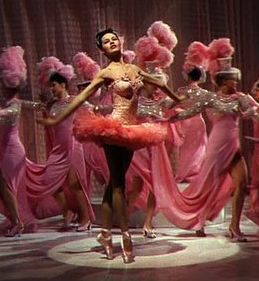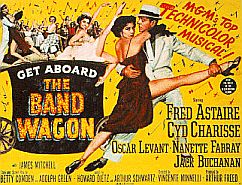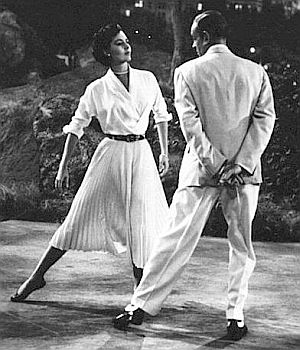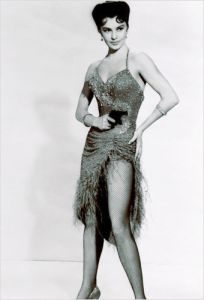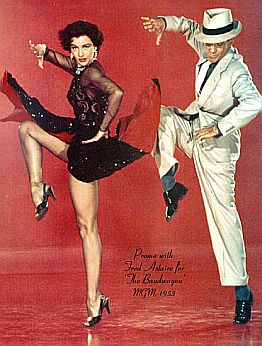“She’s got legs, she knows how to use them,” is a line from a ZZ Top rock `n roll tune entitled “Legs.” The good ol’ boys of ZZ Top likely did not have Cyd Charisse in mind when they wrote this tune — Charisse being the famous statuesque dancer of the 1950s who lit up the silver screen with grace and good looks in the heyday of MGM musicals. Nevertheless, ZZ’s lyrics serve this lady well.
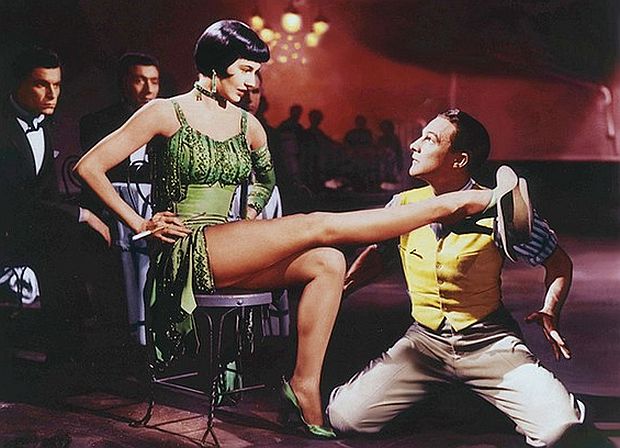
Cyd Charisse with Gene Kelly, from the ‘Broadway Melody Ballet’ sequence in 1952 film, ‘Singin’ in The Rain,’ MGM.
In fact, rumor had it — as did at least one Guinness record book entry — that Charisse’s legs were insured for millions in the 1950s. However, Charisse later reported that this was an MGM-inspired publicity stunt. Still, those legs of hers certainly appeared to be worth every one of those purported millions — and more. For beyond their mere sexy appearance, the legs of Cyd Charisse were made for dancing — and dance this lady did; with poise, power, and entertaining provocation. But it didn’t start out that way for a little girl in Texas.
Born Tula Ellice Finklea in Amarillo, Texas in March 1922, Cyd Charisse had a brush with polio as a child, making dancing seem a pretty remote possibility. But the sickly Tula began dancing at home at the encouragement of her father.By the age of 14 she was dancing with a Russian ballet troupe. He built her a practice bar and a full-length mirror in her bedroom. He wanted her to work and stretch her muscles. She began dance lessons at age 8. “I was this tiny, frail little girl, I needed to build up muscle,” she would say in a later interview, “and I fell in love with dancing from the first lesson.” During a family vacation in Los Angeles when she was 12, her parents enrolled her in classes at a Hollywood ballet school. As a teenager, she returned to the school as a full-time student. One of her teachers there was Nico Charisse, a handsome young dancer. At age 14, she auditioned for and later joined the Ballet Russe de Monte Carlo, touring under Russian-required stage names Natacha Tulaelis and Felia Siderovaa.
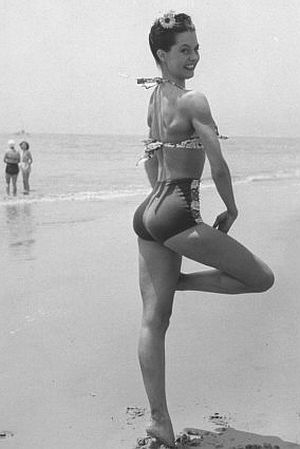
Cyd Charisse, 23-year-old ballet dancer and aspiring film star, posing on a Santa Monica beach in September 1945 for Life magazine photographer, Peter Stackpole.
Her film debut came in 1943 under the name Lily Norwood in Something to Shout About, with Don Ameche and Janet Blair. That role came about when David Lichine was hired for a ballet sequence in the film and he needed a partner. The movie was not a blockbuster, but its ballet sequence attracted notice, and Charisse, still billed as Lily Norwood, began receiving movie offers.
“I had just done that number with David as a favor to him,” she would later explain. “Honestly, the idea of working movies had never once entered my head. I was a dancer, not an actress. I had no delusions about myself. I couldn’t act — I had never acted. So how could I be a movie star?” But movie dance star she would later become, and signed on at MGM with a seven-year contract.
Charisse spent nearly a decade in small roles, sometimes anonymously. She first appeared with Fred Astaire in a brief number in the film Ziegfeld Follies, a star-studded 1946 production that included notables such as Judy Garland, Lucille Ball, Fanny Bryce and others. Charisse also had a solo number early on in that film. She conintued to play supporting roles in other major musicals, including “The Harvey Girls” and “Till the Clouds Roll By,” both in 1946 with Judy Garland. As a kid, she had been nicknamed “Sid” by her brother who had trouble pronouncing “Sis.” Ziegfeld Follies producer Arthur Freed is said to have preferred her married name, Charisse to the stage name Norwood, and he also changed the spelling of Sid to “Cyd,” thus christening her “Cyd Charisse” ever after. By the late 1940s, she was getting more notice in her dance roles. In 1947, she joined Ricardo Montalban in the film Fiesta in which she did a bamba dance and a flamenco number. In 1948, she had a much-praised cameo as a fiesta dancer in The Kissing Bandit with Frank Sinatra. After a serious romance with millionaire Howard Hughes ended, she married singing star Tony Martin in 1948. Offered the lead opposite Gene Kelly in what would become the 1950 Academy Award winning film, An American In Paris, Charisse was then pregnant with son Tony and had to decline. But her big break came in 1952’s Singin’ in the Rain, where she danced memorably with Gene Kelly.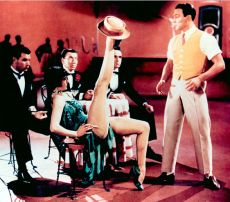 |
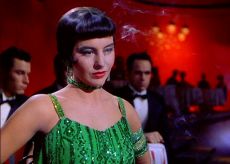 |
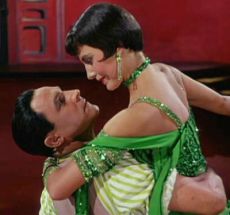 |
 |
 |
“Singin’ in The Rain”
Singin’ in the Rain was an MGM comedy musical released in August 1952. It starred Gene Kelly, Donald O’Connor, and Debbie Reynolds. Reynolds, however, was not a dancer so Kelly chose Charisse to partner with him in the “Broadway Melody” portion of the film, in which Charisse had no dialogue but danced two segments with Kelly. The most memorable of these is the scene in which Charisse appears as a tall and leggy gun moll. Charisse was 5′, 6” tall, but in heels and full-length stockings, she could look much taller.
In the “Broadway Melody” scene, Charisse appears in a green flapper dress, smoking a cigarette with holder. She proceeds to dance seductively around the awe-struck Kelly, who plays the hopeful young dancer looking for a break. As they continue in a dance segment, Kelly’s character remains smitten with the tall beauty. But at scene’s end, she walks off with a wiseguy gangster. For many who first saw the film, the scene with Charisse was especially memorable.
Cinema Uproar
David Shipman, a British film historian and author of the book, The Great Movie Stars, among others, offered this observation of Charisse’s appearance:
“If you were in an Air Force cinema, circa 1952, you’ll never forget the sound which greeted the appearance of Cyd Charisse halfway through the climactic ballet in Singin’ in the Rain. The audience to a man greeted the sinuous leggy beauty with a loud and prolonged ‘Ooooaah!’ As she slithered round an understandably bewildered Gene Kelly, there was uproar in the cinema. Cyd Charisse didn’t do more than dance in Singin’ in the Rain and people remember her in it.”
Film and dance historian Larry Billman also noted of Charisse’s breakthrough dancing in this film that she was “strong, lithe, and drop-dead gorgeous to look at.” Charisse’s style, and the material she had to work with, set her apart from earlier Hollywood dancers.
Sensual, Inventive
“After years when Hollywood’s leading dancers were cute and fluffy,” explained Billman in a 2007 interview with The Los Angeles Times, “Cyd took dance to a more sensual realm in the 1950s.” Working with Kelly, Astaire, and good choreographers, the dancing she did was also sometimes quite inventive.
In another dance sequence with Kelly in Singin’ in the Rain, Charisse is cast at the other extreme of her flapper bad girl — as the elusive ideal dressed in white. She and Kelly then danced a scene in which Charisse stunned critics and audiences by including a long, 25-foot Chinese silk scarf in the dance that floated in the air with the aid of a wind machine.
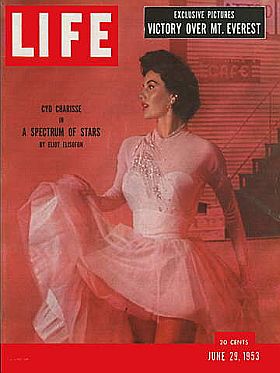
Cyd Charisse on the cover of Life magazine, June 29, 1953, in ‘Spectrum of Stars’ story. Click for copy.
More Notice
In the early 1950s, as she began dancing with Fred Astaire in a series of productions, more national press began to cover her and feature her in major stories. In late June 1953, she appeared on the cover of Life magazine, featured in the story, “A Spectrum of Stars.” Charisse’s good looks fit in well during a Hollywood era in which sex appeal at the box office was the emerging trend, with actresses such as Marilyn Monroe and Sophia Loren among the more appealing and glamorous stars of the big screen. But Charisse, with her beauty and grace, would come to rule the dance portion of that Hollywood world, and in fact, in that era, according to dance historian Larry Billman, would become the personification of dancing sophistication, at least on film.
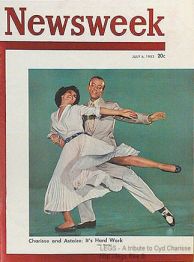
Charisse & Astaire on the cover of Newsweek, July 6, 1953, in advance of 'The Band Wagon's' premiere.
By 1953, she was working with Fred Astaire on the musical that would become The Band Wagon. A July 1953 cover story for Newsweek showed the pair dancing together with the tag line “Charisse and Astaire: It’s Hard Work.” Look magazine also put her on the cover of its August 8, 1953 edition. Charisse had her first lead female role in The Band Wagon, in which she danced with Astaire in two routines — “Dancing in the Dark” and “Girl Hunt Ballet”. The film, a musical comedy, was released in August 1953. It is regarded as among the finest of the MGM musicals, although in its day, it was not a box-office smash. It tells the story of an aging musical star, Astaire, who hopes a Broadway play will restart his career. The film popularized the songs “That’s Entertainment!” and “Dancing in the Dark.”
Perhaps the most famous dance scene in The Band Wagon is the one set in Central Park, with Charisse and Astaire performing to “Dancing in the Dark” (shown practicing on Newsweek cover above) and has become a favorite of many Charisse and Astaire fans. Another dance sequence shot for The Band Wagon, but not used in final film, featured Charisse in a seductive routine performing “Two-Faced Woman”. However, that scene was later incorporated into the Hollywood retrospective, That’s Entertainment! III, first released in 1994.
The Band Wagon, meanwhile, was selected for preservation in the United States National Film Registry by the Library of Congress in 1995. The American Film Institute has also named it among “best musicals,” ranking it at No. 17 in 2006.
In 1954 Charisse co-starred with Gene Kelly in the Scottish-themed musical Brigadoon, adapted from the 1947 Broadway show by the famous team of Alan Lerner and Frederick Loewe. Although not known for her acting skills, as she did not have the theatrical training that even some Hollywood dancers did, film viewers found that Charisse gave a believable performance in her somewhat vulnerable Brigadoon character.
In the story, American tourists Gene Kelly and Van Johnson stumble upon a mysterious Scottish village that materializes only once every 100 years. There, Kelly falls for a beautiful villager named Fiona played by Charisse, and they dance together twice in the film to “The Heather on the Hill.”
Kelly’s character in the story learns that his love for Fiona will make it possible for him to remain in Brigadoon forever. But he is unwilling to commit himself and backs down as Brigadoon disappears at its appointed hour. Back in New York City, he can think only of Fiona and returns to Scotland. There, his love for Fiona causes Brigadoon to materialize and he crosses the bridge into the village to be with Fiona forever.
In December 1954, Deep in My Heart was released, an MGM film in which Charisse received notice for a sexy duet she danced with James Mitchell. A lead role for Charisse in another pairing with Gene Kelly came in MGM’s 1955 musical, It’s Always Fair Weather, a film that some believe was much underrated.A number of Charisse’s fans praise her performance in the film’s dance number, “Baby You Knock Me Out.” It’s Always Fair Weather was among the final group big 1950s musicals. Critically acclaimed, the film had modest box office success. It was also the last film co-directed by Gene Kelly and Stanley Donen.
In Meet Me in Las Vegas (1956), Charisse has more dance scenes. In one, as Sammy Davis Jr. croons the tragic jazz ballad “Frankie and Johnny,” Charisse commands the scene dancing across a nightclub’s floor. She is dressed in a tight sequined gown slit to her thigh, with four-inch high heels, admirers later marveling that she could move at all, let alone dance. In the number at one point, she grabs a pistol, vaults over the bar, and shoots her two-timing lover, pivoting around for the final take, shaking her tail feather at the close.
|
Astaire vs. Kelly Gene Kelly and Fred Astaire were very different dance partners for Cyd Charisse, as she explained in a 1992 New York Times interview: “Gene was always interested in ballet, and he was more of a ballet partner. He was more of a physical dancer…” As for Astaire, she said, on some occasions he was the perfect partner: “Fred moved like glass. Physically, it was easy to dance with him. It was not as demanding on me. I didn’t need the same vitality and strength.” In her autobiography, Charisse also reflected on her experience with Astaire and Kelly: “As one of the handful of girls who worked with both of those dance geniuses, I think I can give an honest comparison. In my opinion, Kelly is the more inventive choreographer of the two. Astaire, with [choreographer] Hermes Pan’s help, creates fabulous numbers — for himself and his partner. But Kelly can create an entire number for somebody else … I think, however, that Astaire’s coordination is better than Kelly’s … his sense of rhythm is uncanny. Kelly, on the other hand, is the stronger of the two. When he lifts you, he lifts you! … To sum it up, I’d say they were the two greatest dancing personalities who were ever on screen. But it’s like comparing apples and oranges. They’re both delicious.” |
By 1957, Charisse was back with Fred Astaire in the film Silk Stockings, which was a musical remake of 1939’s film Ninotchka. Taking the role formerly played by Greta Garbo, Charisse is a Russian efficiency expert who is sent to Paris to bring back a defecting pianist and three commissars who have become bewitched by western ways. There she meets and falls for carefree Hollywood producer played by Fred Astaire. She and Fred then dance to Cole Porter tunes such as “All of You” and “Fated to Be Mated.” In Fred Astaire’s autobiography, he pays tribute to Charisse, calling her “beautiful dynamite” and writing: “That Cyd! When you’ve danced with her you stay danced with.” Silk Stockings was Charisse’s last major musical, as that era of Hollywood film-making was coming to an end. Television began winning audience share just as Hollywood musicals became more expensive to make. Foreign audiences weren’t buying either. So MGM began dismantling its collection of talent.
With the decline of the Hollywood musical, Charisse retired from dancing but continued to appear in film and TV productions. In 1958 she played opposite Rock Hudson in a dramtic role in Twilight for The Gods, a film about a court-martialed Navy captain who turns to drink while sailing a rundown schooner in the South Seas with a disparate group of passengers on board. That year she also played opposite Robert Taylor in Party Girl, a ganster film in which she did two dance scenes that some critics felt were overlooked. In 1962, she took on a dramatic role as Kirk Douglas’s wife in Two Weeks in Another Town. She also had a supporting role that year in Something’s Got To Give, the last, unfinished film of Marilyn Monroe.
By 1964 Cyd and husband Tony Martin had launched a successful nightclub act that was taken to Las Vegas and other cities. In 1966, she appeared with Dean Martin in The Silencers, a spy movie spoof. She also had a few successful TV specials, and made guest appearances on a number of TV shows, including Hawaii Five-O and The Love Boat in the 1970s, and Murder, She Wrote in the 1980s. She also worked in theater in the 1980s, performing in Charlie Girl in London. One blogger, R.A.D. Stainforth, wrote of seeing Charisse in Charlie Girl at the Victoria Palace theater in the mid-1980s when “London theatregoers gave her a huge ovation.”
|
“Meet Cyd Charisse” As the glory days of the MGM movie musicals began to fade in the late 1950s, some of the Hollywood stars — including Cyd Charisse and her husband Tony Martin — began doing television specials. On December 29, 1959, for example, a musical variety show named Meet Cyd Charisse aired on the NBC television network as part of the Ford Startime series showcasing various stars. The Ford series ran for about two years in 1959 and 1960. In this episode starring Cyd Charisse, there was dancing, singing, and comedy sketches and a company of over 20 dancers. In one act, Charisse and dance partner James Mitchell did a dramatic ballet set on the Hong Kong waterfront involving a mini-storyline about an ill-fated romance between an Oriental entertainer and a thief. Another dance with Charisse and Mitchell featured a romantic story set to Gershwin’s “Love Walked In.” Charisse also did a song and dance number with husband Tony Martin and two featured dancers, one of whom was Mary Tyler Moore. Another dance and short sketch featured comedienne Eve Arden and dancer Ray Kellogg educating coffeehouse beatniks on the dance and music of the flapper generation. There was also a Tropical Rhythms dance sketch performed by Charisse and a dance ensemble. The show closed with a “last dance” performed by Charisse and other of the show’s guests. 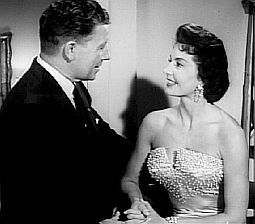 ‘MGM Parade’ was an earlier, 1955-56 TV show MGM sought to use to promote its stars & films. Cyd Charisse & George Murphy are shown here. In the 1960s, she and husband Tony Martin would do similar variety shows on the Hollywood Palace series on the ABC television network, mostly in the 1964-1967 period. Charisse would sometimes host the special, with Martin and other guests performing. Charisse also starred in two TV concert specials — “The Cyd Charisse Special” and “Center Stage: Cyd Charisse” in 1967 and 1968. She would later explain that she and husband Tony, would often take their television material on the road, doing shows in Europe and elsewhere. A decade earlier, in the mid-1950s, some of the Hollywood film studios had sought to use television to improve their lot at the box office. MGM Parade was the name of a 1955-56 TV show that MGM tried to use to promote its stars and films. But by the late 1950s, and continuing through the 1960s, the TV variety show — like those described above — had essentially carved up the old Hollywood musicals format for use in shorter-length TV segments. |
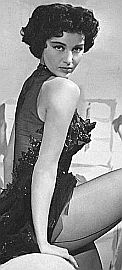
Cyd Charisse, 1953.
At her passing, there was much remembrance and recognition of her style and contribution to film and dance. “She Put The Move In Movies,” said the Washington Post headline at her death, continuing — “Cyd Charisse Danced Rings Around Even the Best.” The Boston Globe’s headline said, “Cyd Charisse Was a Cool Classic,” with that story calling her “the choreographic equivalent of a classic Sinatra LP.” “Charisse had a whole different way of carrying herself, pulled-up and light, those legs stroking forward like a cat’s…”
— Sarah Kauffman,
Washington Post.
Charisse, said the Globe, “expressed her persona through movement rather than dialogue — and in her case that persona was smoky, sinuous, and cool: a quintessential ’50s mix of sex and poise.” Charisse herself remarked to Anna Kisselgoff of the New York Times in 1992: “I think that in all my dancing I play a role. To me, that’s what dancing is about. It’s not just steps.” Certainly in film, her innovative approach to dance, coupled with her sensuous appeal made her an all-time audience favorite. Her contributions to MGM and the Golden Age of Hollywood musicals remain in a class all their own. “Unlike the other great movie dancers…,” wrote Sarah Kaufman of the Washington Post, “Charisse had a whole different way of carrying herself, pulled-up and light, those legs stroking forward like a cat’s, because she had been a ballerina before she ever danced a step with Fred Astaire or Gene Kelly.” She brought something special to her craft and the silver screen. Adds Kauffman: “Charisse, with those legs and that heart, was a choreographer’s dream, an instrument in heavenly form, willing, smart and musical.”
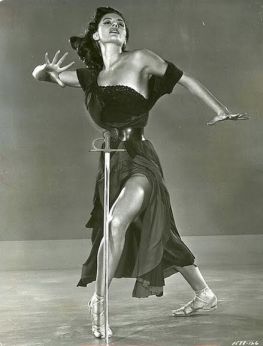
Cyd Charisse in “purification” Gypsy Dance from 1953 film “Sombrero,” seeking atonement for death of her bullfighter brother. Click for DVD.
But Cyd Charisse, it seems, also kept a bit of humility about her. “I never thought of myself as a ‘Star,’ not even after I made my biggest films,” she would say in later years. “Perhaps that’s because I am basically an introvert. I knew that I loved working, performing. What the public made of it was their business. I hoped that they liked me and admired my work, of course, but that pedestal they stuck me up on was insignificant in my view.”
Yet clearly, her contributions to dance and musical expression during a unique era of movie making remain in a place of high regard.
See also at this website, “Charisse & Astaire: Girl Hunt Ballet, 1953.” Readers may also find “Ava Gardner” of interest, or “Bette Davis Eyes,” a story about Davis and a popular 1981 song about her. See also the “Film & Hollywood” page or the “Noteworthy Ladies” topics page for additional story choices in those categories. Thanks for visiting – and if you like what you find here, please make a donation to help support the research and writing at this website. Thank you. – Jack Doyle
|
Please Support Thank You |
_________________________
Date Posted: 7 September 2009
Last Update: 8 December 2019
Comments to: jdoyle@pophistorydig.com
Article Citation:
Jack Doyle, “Legs: Cyd Charisse, 1950s-1990s,”
PopHistoryDig.com, September 7, 2009.
_________________________
Sources, Links & Additional Information
 Charisse on cover of UK’s Dec. 1955 ‘Picturegoer’ mag: ‘she’s got THE perfect figure.’ |
 Fred Astaire & Cyd Charisse in promo photo for 1953 musical film, ‘The Band Wagon.’ |
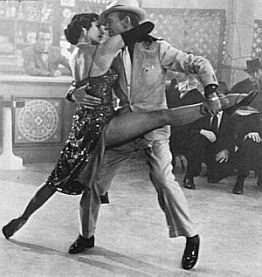 Fred Astaire & Cyd Charisse in dance scene from 1953's ‘The Band Wagon.’ |
Bosley Crowther, “‘Singin’ in the Rain,’ Starring Gene Kelly, Ushers In Spring at the Music Hall…,” New York Times, Friday, March 28, 1952, Amusements, p. 27.
Thomas M. Pryor, “Stardom Planned for Cyd Charisse; M-G-M Officials Preparing New Musical, ‘Songs of Solomon,’ as Lead Vehicle for Dancer,” New York Times, Tuesday, March 31, 1953, p. 36.
Eliot Elisofon, “A Spectrum of Stars,” Life, June 29, 1953.
Thomas M. Pryor, “Warners Has Film for Cyd Charisse; Studio Negotiating to Borrow Her from M-G-M for Title Role in ‘Helen of Troy’,” New York Times, Wednesday, February 10, 1954, p.38.
Cyd Charisse cover photo, Picturegoer (UK), December 1955.
Bosley Crowther, “The Screen: ‘Silk Stockings’ Arrives; Fred Astaire and Cyd Charisse Co-Star,” New York Times, Friday, July 19, 1957, p. 11.
“Meet Cyd Charisse,” New York Times Magazine, Sunday, November 22, 1959, p. 102.
“Film Role Given to Cyd Charisse; Actress Will Co-Star With Taylor in ‘Party Girl’…,” New York Times, Monday, August 19, 1957, p.17.
Val Adams, “Bing Crosby Show Listed by A.B.C.-TV; Star’s 4 Sons May Appear With Him on Sept. 29 – Cyd Charisse Is Sought,” New York Times, Monday July 6, 1959, Business, p. 49.
Jack Gould, “TV Review; Cyd Charisse Makes Debut on ‘Startime’,” New York Times, Wednesday, December 30, 1959, Business, p. 45.
Anna Kisselgoff, “Dance; Cyd Charisse’s Dance Card Is Full Once More,” New York Times, April 5, 1992.
“Singing in the Rain,” WetCircuit.com, October 16, 2006.
“Meet Me In Las Vegas,” WetCircuit.com, February 1, 2007.
Bob Thomas, Associated Press, “Cyd Charisse, 86: Danced with Astaire, Kelly,” TheStar.com, June 17, 2008.
Mary Rourke, “Cyd Charisse, 86; Dancer Starred in Movie Musicals with Gene Kelly, Fred Astaire,”Los Angeles Times, June 18, 2008.
Robert Berkvist, “Cyd Charisse, 86, Silken Dancer of Movies, Dies,” New York Times, June 18, 2008.
Joe Holley and Adam Bernstein, “Cyd Charisse, 86; Actress Danced Across Silver Screen,” Washington Post, Wednesday, June 18, 2008, p. B-5.
Reuters, “Actress and Dancer Cyd Charisse Dies at 86,” June 19, 2008.
Sarah Kaufman, “She Put The Move In Movies; Cyd Charisse Danced Rings Around Even the Best,” Washington Post, Thursday, June 19, 2008, p. C-1.
Manohla Dargis, “An Appraisal: Sylph or Siren, the Legs Have It,” New York Times, June 19, 2008.
“Cyd Charisse,” Wikipedia.org.
Staff Reporter, “Cyd Charisse, The Lady With Legs Worth $1 Million, Dies Aged 86,” Daily Mail, (MailOnLine, U.K.), June, 18, 2008.
Cyd Charisse — Archive Interview, You Tube, Part 2 of 4 (25 minutes), by Archive of American Television.
Tony Martin and Cyd Charisse, as told to Dick Kleiner, The Two of Us, New York: Mason/Charter, 1976.
Andre Soares, “Cyd Charisse,” Alternative Film Guide, June 17, 2008.
‘Most Valuable Legs’ entry in the 2001 Guinness Book of Records, notes a $5 million insurance policy reportedly accepted on the legs of Cyd Charisse in 1952.
Cyd Charisse Website.
Cyd Charisse Fan Site, “Legs: A Tribute to Cyd Charisse.” Extensive site with photos.
James Robert Parish and Ronald L. Bowers, The MGM Stock Company, The Golden Era, New Rochelle, N.Y., 1974.
Fred Astaire, Steps in Time, Harper, 1959, 338 pp.
“Meet Cyd Charisse,” Ford Startime, NBC-TV, Season 1, Episode 13, December 29,1959.
TV Show, Hollywood Palace, ABC-TV, Season 2, Episode 18, Host: Cyd Charisse, January 30, 1965.
“Cyd Charisse, Biography,” Turner Classic Movies, TCM.com, 2009.
Larry Billman, Film Choreographers and Dance Directors: An Illustrated Biographical Encyclopedia, With a History and Filmographies, 1893 Through 1995, McFarland & Company, 1997, 252pp.
Hugh Fordin, M-G-M’s Greatest Musicals: The Arthur Freed Unit, Da Capo Press, 1996, 576pp.
Lawrence Thomas, The Golden Age of Movie Musicals: The MGM Years, Columbia House,1972.
Jane Feuer, The Hollywood Musical, Indiana University Press; 2nd Edition, 1993, 176 pp.
Clive Hirschhorn, Gene Kelly: A Biography, St. Martins Press,1985, 296 pp.
“A Conversation with Actors and Dancers Ann Miller, Skitch Henderson, Cyd Charisse and Van Johnson about the Heyday of Hollywood Movie Musicals and a 1997 Tribute entitled ‘MGM at Carnegie Hall’,” The Charlie Rose Show, Monday, July 14, 1997 (video, 26:35 minutes).
________________________________________
